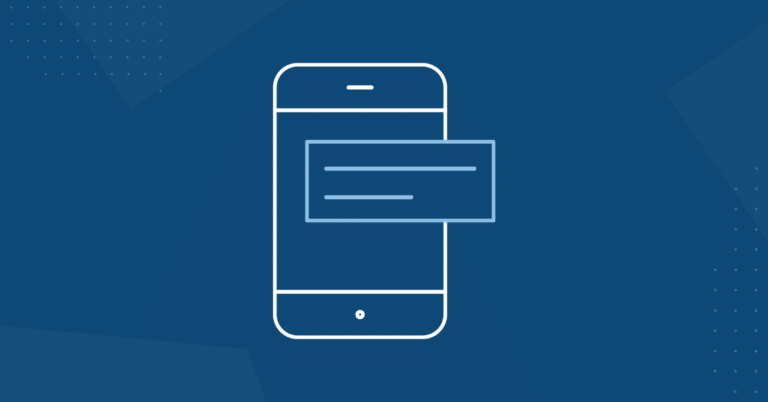If app acquisition is one of the main goals of an app marketer, then retention needs to be at the top of that list as well — especially since 21% of app users churn after using an app just once. This means that without a solid user retention strategy that convinces users to continuously come back, money spent on user acquisition goes to waste.
The purpose of user retention is to get users to consistently come back to your app to foster brand loyalty and increase user lifetime value. This directly goes hand in hand with increasing ROI and revenue — the longer a user has a relationship with your brand, the more likely they are to perform the in-app actions that define your business KPIs.
Here are five tips for better mobile app retention strategies to implement this year and beyond:
Tip 1: Effective Onboarding
Introduce new users to your app without overwhelming them by keeping the onboarding process simple yet effective. If you take users through complicated features of your app too early, you risk confusing your users, leading to drop off and churn. Guide users through the key features of your app that bring them immediate value. Once users are acquainted with your app, then explain the more complex inner workings via visuals and easy-to-follow steps.
Another way to make onboarding more effective is to personalize the onboarding process according to user preferences or segments. This is highly dependent on the type of app your business has, but applies in a variety of scenarios. If you’re a content-first app, this could look like collecting information about the type of content users enjoy. Meanwhile, a fashion retailer app might ask users about their favorite brands. And an exercise app could ask its users what their exercise goal is in order to personalize workout sets to fit their needs. Create moments in onboarding that let users personalize their experience with your app to make it more relevant to their interests and goals.
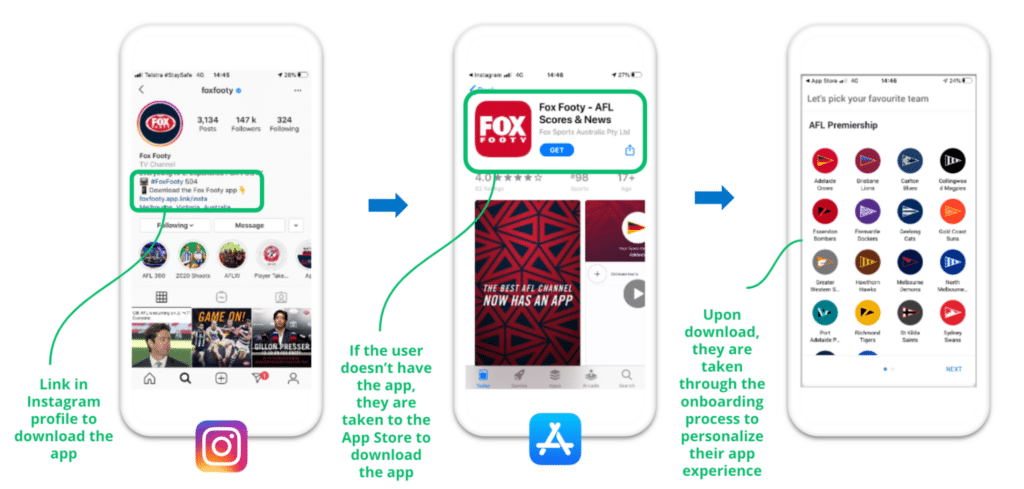
An example of personalized onboarding from Fox Footy. After downloading the Fox Footy app, users are asked to choose their favorite team to personalize their app experience. This increases the chances the user will continuously engage in the app over time, leading to higher retention.
Tip 2: Push Notifications
Don’t be annoying, but also don’t be afraid to remind your users why they should come back to you. One of the most popular methods to increase app engagement rates are push notifications. Push notifications often have a reputation for being infuriating, and it’s true that ill-timed or irrelevant push notifications certainly can be. However, once you perfect your push notifications and their timing, they can be a powerful method to remind users to open and engage with your app. Make push notifications tailored to your users’ needs, behavior and interests to increase their relevancy and make users more likely to click. For example, eCommerce apps could send push notifications that let users know when an item they’ve viewed or left in their cart is on sale. By using push notifications to notify users of app-only incentives or time-sensitive deals, you pique users’ interest and create a sense of urgency and fear of missing out. This then helps prompt them to go back into your app to complete the relevant in-app action.
Using Branch’s deep links, you can ensure your push notifications seamlessly bring users to the relevant in-app content to increase retention and conversion rates. By using deep links in your personalized push notification strategy, you reduce the chances of user dropoff, and create a user experience that leaves users coming back for more.
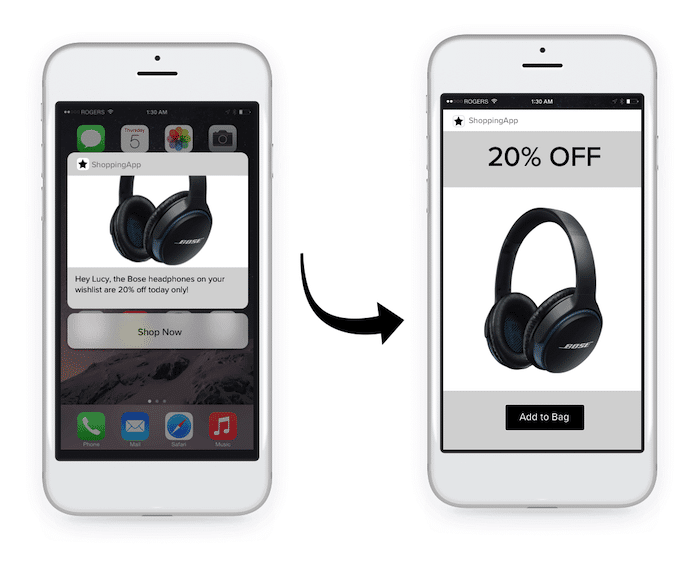
In the image above, the fictional app ShoppingApp uses push notifications to remind users to come back to their app. By reminding users of their app through push notifications, as well as enticing users through discounts, users will see the discount and click on the notification to bring them back to your app.
3. Use Content to Engage Users
Creating new and engaging content is a cost-effective method to keep your users interested. Whether your content is educational, addresses user pain points, or is a source of light entertainment, what matters is how well it captures users’ attention, fosters brand loyalty, and brings them back to your app. Content that users can easily respond to, like interactive Instagram stories, polls, video challenges, and competitions, is another way to encourage continuous engagement and higher retention rates.
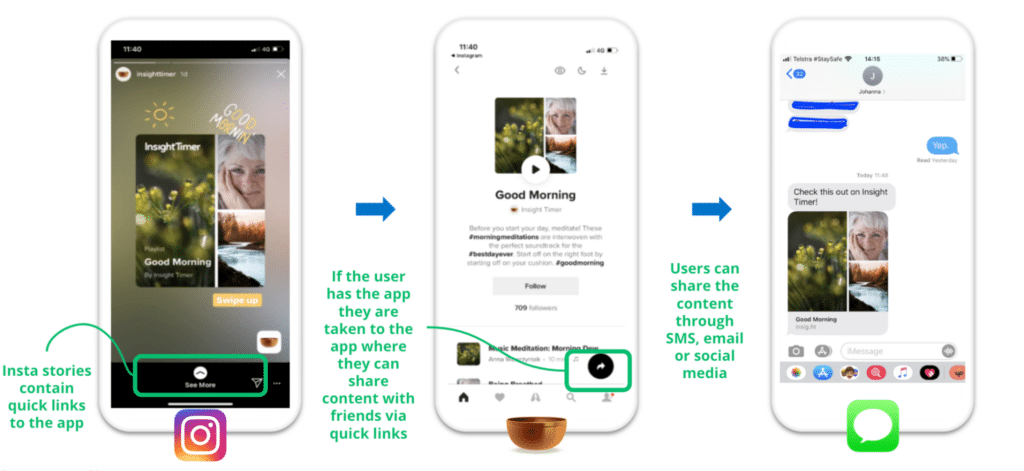
Insight Timer creates Instagram stories to encourage user interaction. When users swipe up on the story, those who have the app are taken directly to the relevant in-app content, ensuring a smooth user experience and reducing friction. Not only should your content be interesting and engaging, it also needs to route users to the right place in your app.
4. Run a re-engagement ad campaign
Paid re-engagement campaigns are one of the most popular and reliable app retention strategies. They consist of running ads targeted towards users who already have your app, in order to get them to perform a specific in-app action. This could look like running ads for other apps or websites you know your users are likely interested in. By partnering with ad networks, you can launch wide-reaching campaigns towards a certain user segment. For example, you could continuously show re-engagement ads to current users to save them from churning in the first place, win back users who have already lapsed, or show ads to users who have not interacted with your app in a certain amount of time.
Many networks support showing retargeting ads to custom user segments based on time since last engagement. These ads can be particularly effective on a CPA basis because they do not have the dropoff rates of install ads, where a user must first download the app to transact.
To optimize your CPA and minimize friction, use deep linking to take users with the app directly to advertised products and content.
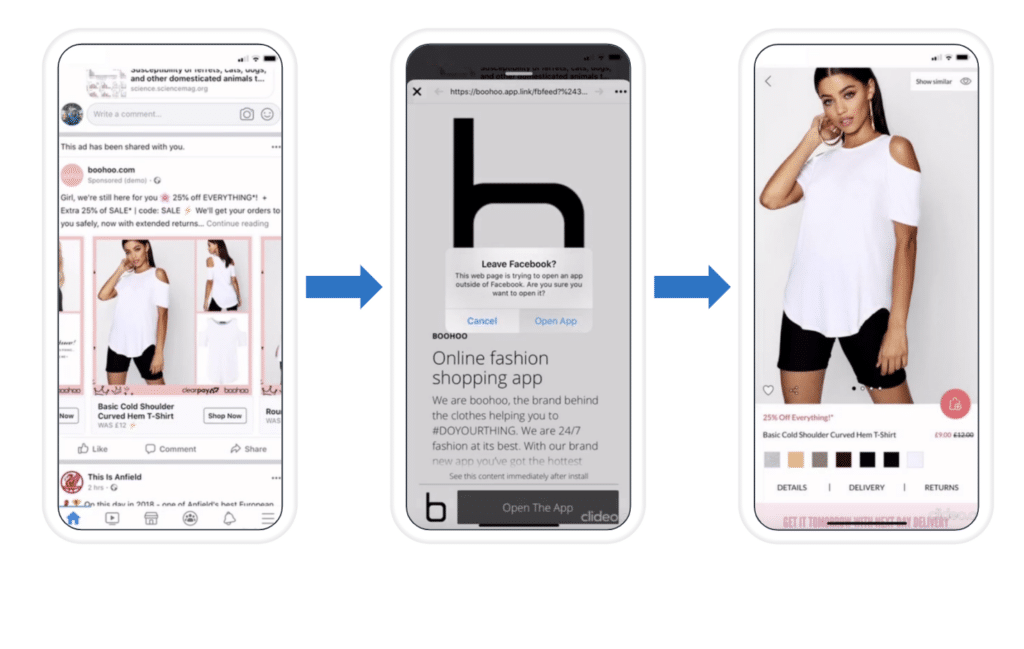
Boohoo runs re-engagement ads on Facebook. After the user clicks the ad, they are brought into the Boohoo app for an easy shopping and checkout experience, eliminating user dropoff and churn.
One caveat with this strategy is that paid re-engagement ads are now much harder to effectively run and measure on due to the deprecation of device-level data (like the IDFA) on iOS. Without explicit user consent to data sharing via Apple’s App Tracking Transparency framework, brands cannot access device-level data to perform personalized retargeting campaigns. This makes it extremely difficult to know which users to target — and what types of ads to target them with. However, if you do obtain user consent, paid re-engagement ads can be strategically and intelligently used along with owned and organic methods to prevent churn and revive dormant users.
An added bonus in using deep links in your re-engagement campaigns? With web fallback experiences enabled, you can make sure that efforts at re-engagement don’t accidentally deter your users, in case they don’t have the app installed.
5. Integrate SEO into your retention strategy
SEO is often thought of as an acquisition strategy, but the same principles that make intent-based SEO a powerful acquisition tactic also work well in user retention strategies. Make it a priority to understand the intent and behavior of long-term engaged users — doing so provides insight into the keywords or phrases that similar lapsed users may be searching outside your app. By creating content that incorporates these keywords into your SEO strategy, you help users with high-intent but low usage find their way back into your app, boosting retention and lifetime value.
Learn more about how to incorporate intent-based SEO into your mobile growth and retention strategy in our whitepaper.
Convincing users to stick around can be a challenge, but it’s one of the most critical elements of any mobile marketing strategy. Think of retention encompassing all stages of the funnel instead of a separate entity, and you’ll be on your way to higher user retention rates, LTV, and app growth in no time.






















